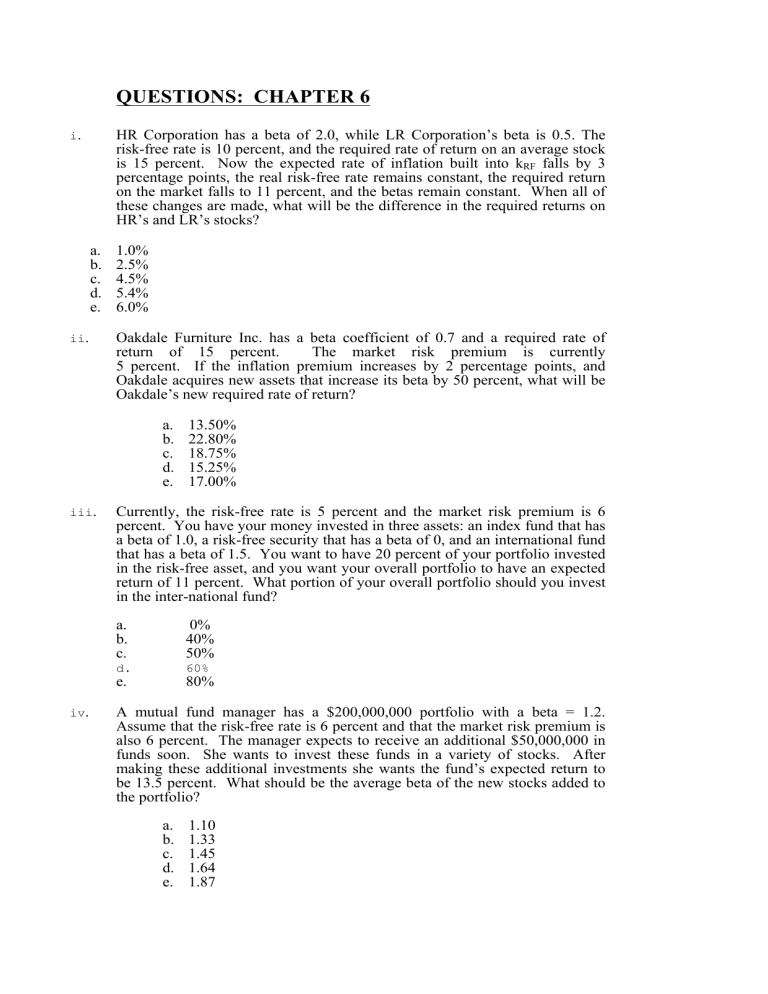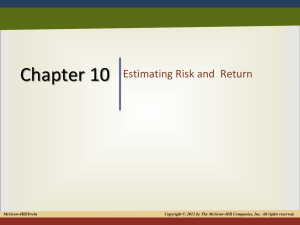
QUESTIONS: CHAPTER 6 i. HR Corporation has a beta of 2.0, while LR Corporation’s beta is 0.5. The risk-free rate is 10 percent, and the required rate of return on an average stock is 15 percent. Now the expected rate of inflation built into kRF falls by 3 percentage points, the real risk-free rate remains constant, the required return on the market falls to 11 percent, and the betas remain constant. When all of these changes are made, what will be the difference in the required returns on HR’s and LR’s stocks? a. b. c. d. e. ii. 1.0% 2.5% 4.5% 5.4% 6.0% Oakdale Furniture Inc. has a beta coefficient of 0.7 and a required rate of return of 15 percent. The market risk premium is currently 5 percent. If the inflation premium increases by 2 percentage points, and Oakdale acquires new assets that increase its beta by 50 percent, what will be Oakdale’s new required rate of return? a. b. c. d. e. iii. Currently, the risk-free rate is 5 percent and the market risk premium is 6 percent. You have your money invested in three assets: an index fund that has a beta of 1.0, a risk-free security that has a beta of 0, and an international fund that has a beta of 1.5. You want to have 20 percent of your portfolio invested in the risk-free asset, and you want your overall portfolio to have an expected return of 11 percent. What portion of your overall portfolio should you invest in the inter-national fund? a. b. c. 0% 40% 50% d. 60% e. iv. 13.50% 22.80% 18.75% 15.25% 17.00% 80% A mutual fund manager has a $200,000,000 portfolio with a beta = 1.2. Assume that the risk-free rate is 6 percent and that the market risk premium is also 6 percent. The manager expects to receive an additional $50,000,000 in funds soon. She wants to invest these funds in a variety of stocks. After making these additional investments she wants the fund’s expected return to be 13.5 percent. What should be the average beta of the new stocks added to the portfolio? a. b. c. d. e. 1.10 1.33 1.45 1.64 1.87 v. A portfolio manager is holding the following investments: Stock X Y Z Amount Invested Beta $10 million 1.4 20 million 1.0 40 million 0.8 The manager plans to sell his holdings of Stock Y. The money from the sale will be used to purchase another $15 million of Stock X and another $5 million of Stock Z. The risk-free rate is 5 percent and the market risk premium is 5.5 percent. How many percentage points higher will the required return on the portfolio be after he completes this transaction? a. b. c. d. e. vi. 0.07% 0.18% 0.39% 0.67% 1.34% You have been scouring The Wall Street Journal looking for stocks that are “good values” and have calculated expected returns for five stocks. Assume the risk-free rate (kRF) is 7 percent and the market risk premium (kM - kRF) is 2 percent. Which security would be the best investment? (Assume you must choose just one.) Expected Return Beta a. 9.01% 1.70 b. 7.06% 0.00 c. 5.04% -0.67 d. 8.74% 0.87 e. 11.50% 2.50 vii. A money manager is holding the following portfolio: Stock Amount Invested 1 2 3 4 $300,000 300,000 500,000 500,000 Beta 0.6 1.0 1.4 1.8 The risk-free rate is 6 percent and the portfolio’s required rate of return is 12.5 percent. The manager would like to sell all of her holdings of Stock 1 and use the proceeds to purchase more shares of Stock 4. What would be the portfolio’s required rate of return following this change? a. b. c. d. e. viii. 13.63% 10.29% 11.05% 12.52% 14.33% An investor has $5,000 invested in a stock that has an estimated beta of 1.2, and another $15,000 invested in the stock of the company for which she works. The risk-free rate is 6 percent and the market risk premium is also 6 percent. The investor calculates that the required rate of return on her total ($20,000) portfolio is 15 percent. What is the beta of the company for which she works? a. b. c. d. e. ix. 1.6 1.7 1.8 1.9 2.0 The following probability distributions of returns for two stocks have been estimated: Returns Probability 0.3 0.4 0.3 Stock A 12% 8 6 Stock B 5% 4 3 What is the coefficient of variation for the stock that is less risky, assuming you use the coefficient of variation to rank riskiness. a. b. c. d. e. x. 3.62 0.28 0.19 0.66 5.16 Currently, the risk-free rate, kRF, is 5 percent and the required return on the market, kM, is 11 percent. Your portfolio has a required rate of return of 9 percent. Your sister has a portfolio with a beta that is twice the beta of your portfolio. What is the required rate of return on your sister’s portfolio? a. b. c. d. e. 12.0% 12.5% 13.0% 17.0% 18.0% SOLUTIONS CHAPTER 6 i. CAPM and required return bHR = 2.0; bLR = 0.5. No changes occur. kRF = 10%. Decreases by 3% to 7%. kM = 15%. Falls to 11%. Now SML: ki = kRF + (kM - kRF)bi. kHR = 7% + (11% - 7%)2 = 7% + 4%(2) = 15% kLR = 7% + (11% - 7%)0.5 = 7% + 4%(0.5) = 9 Difference 6% ii. Required return Answer: e Diff: M Answer: c Diff: M Before: ks = 15% = kRF + (5%)0.7; kRF = 15% - 3.5%; kRF = 11.5%. New kRF = 11.5% + 2.0% = 13.5%. New beta = 0.7 × 1.5 = 1.05. After: New required rate of return: ks = 13.5% + (5%)1.05 = 18.75%. iii. CAPM and portfolio return Answer: b Diff: M N Step 1: Determine the returns on each of the 3 assets: kRF = 5%; kM - kRF = 6%. kRF = 5%. kIndex = kRF + (kM - kRF)b = 5% + (6%)(1.0) = 11%. kInt'l Step 2: = 5% + (6%)(1.5) = 14%. Let X be the portion of the portfolio invested in the international fund, and let (0.8 – X) be the portion invested in the index fund: 11% = 0.2(kRF) + (X)(kInt'l) + (0.8 - X)(kIndex) 11% = 0.2(5%) + (14%)X + (0.8)(11%) - (11%)X 11% = 1% + 14%X + 8.8% – 11%X 11% - 1% - 8.8% = (14% - 11%)X 1.2% = 3%X X = 0.4. Therefore, 40 percent should be invested in the international fund. iv. Portfolio beta Answer: c After additional investments are made, for the entire fund to have an expected return of 13.5%, the portfolio must have a beta of 1.25 as shown by 13.5% = 6% + (6%)b. Since the fund’s beta is a weighted average of the betas of all the individual investments, we can calculate the required beta on the additional investment as follows: Diff: M ($200,000,000 × 1.2) ($50,000,000 × X) + $250,000,000 $250,000,000 1.25 = 0.96 + 0.2X 0.29 = 0.2X X = 1.45. 1.25 = v. Portfolio return Answer: c Diff: M N Find the initial portfolio’s beta and its required return. Then, find the new beta and new required return. Then subtract the two. Step 1: The portfolio beta is the weighted average beta of the stocks in the portfolio. The total invested is $70 million ($10 + $20 + $40). ⎛ $10 ⎞ ⎛ $20 ⎞ ⎛ $40 ⎞ bOld = ⎜ ⎟ (1.4) + ⎜ ⎟ (1.0) + ⎜ ⎟ (0.8) ⎝ $70 ⎠ ⎝ $70 ⎠ ⎝ $70 ⎠ bOld = 0.9429. kOld Step 2: Now, change the weights. The amount of X owned is now $25 million ($10 + $15), the amount of Y owned is now $0 million, and the amount of Z owned is $45 million ($40 + $5). ⎛ $25 ⎞ ⎛ $45 ⎞ ⎛ $0 ⎞ bNew = ⎜ ⎟ (1.4) + ⎜ ⎟ (0.8) ⎟ (1.0) + ⎜ ⎝ $70 ⎠ ⎝ $70 ⎠ ⎝ $70 ⎠ bNew = 1.0143. kNew Step 3: = kRF + (kM – kRF)b = 5% + (5.5%)(0.9429) = 10.1857%. = kRF + (kM – kRF)b = 5% + (5.5%)(1.0143) = 10.5786%. Now subtract the two returns: 10.5786% - 10.1857% = 0.3929%. vi. Expected and required returns Answer: b By calculating the required returns on each of the securities and comparing required and expected returns, we can identify which security is the best investment alternative; that is, the security for which the expected return exceeds the required return by the largest amount. The expected and required returns and the differences between them are shown below: Security Expected Return Required Return A 9.01% 7% + 2%(1.7) = 10.40% B 7.06% 7% + 2%(0.0) = 7.00% C 5.04% 7% + 2%(-0.67) = 5.66% D 8.74% 7% + 2%(0.87) = 8.74% E 11.50% 7% + 2%(2.50) = 12.00% Clearly, security B is the best alternative. Expected-Required -1.39% 0.06% -0.62% 0.00% -0.50% Diff: M vii. Step 1: Portfolio required return Answer: a Diff: T Find the beta of the original portfolio by taking a weighted average of the individual stocks’ betas. We calculate a beta of 1.3. ⎡⎛ $300,000 ⎞ ⎟⎟ (0.6) + ⎢⎜⎜ ⎣⎝ $1,600,000⎠ ⎛ $300,000 ⎞ ⎜⎜ ⎟⎟ (1) + ⎝ $1,600,000⎠ ⎛ $500,000 ⎞ ⎜⎜ ⎟⎟ (1.4) + ⎝ $1,600,000⎠ ⎤ ⎛ $500,000 ⎞ ⎜⎜ ⎟⎟ (1.8)⎥ $1,600,000 ⎝ ⎠ ⎦ Step 2: Find the market risk premium using the original portfolio. ks = 0.125 = 0.06 + (kM - kRF)1.3. If you substitute for all the values you know, you calculate a market risk premium of 0.05. Step 3: Calculate the new portfolio’s beta. The question asks for the new portfolio’s required rate of return. We have all of the necessary information except the new portfolio’s beta. Now, Stock 1 has 0 weight (we sold it) and Stock 4 has a weight of $800,000/$1,600,000 = 0.5. The portfolio’s new beta is: ⎛ $300,000 ⎞ ⎜⎜ ⎟⎟ (1) + ⎝ $1,600,000⎠ ⎛ $500,000 ⎞ ⎜⎜ ⎟⎟ (1.4) + ⎝ $1,600,000⎠ ⎛ $800,000 ⎞ ⎜⎜ ⎟⎟ (1.8) = 1.525. ⎝ $1,600,000⎠ Step 4: Find the portfolio’s required return. Thus, ks = 0.06 + (0.05)1.525 13.63%. = 13.625% ≈ viii. Beta coefficient Answer: a First find the portfolio’s beta: 15% = 6% + (6%)bp 9% = 6%bp bp = 1.5. Let bc be the beta of the company for which she works. The portfolio’s beta is a weighted average of the individual betas of the stocks in the portfolio. Therefore, 1.5 1.5 1.2 bC = = = = ($5,000/$20,000)1.2 + ($15,000/$20,000)bC. 0.3 + 0.75bC 0.75bC 1.6. Diff: M ix. Coefficient of variation Answer: c Diff: M Expected return for stock A is 0.3(12%) + 0.4(8%) + 0.3(6%) = 8.6%. Expected return for stock B is 0.3(5%) + 0.4(4%) + 0.3(3%) = 4%. Standard deviation for stock A is: [0.3(12% - 8.6%)2 + 0.4(8% - 8.6%)2 + 0.3(6% - 8.6%)2]1/2 = 2.3749%. Similarly, the standard deviation for stock B is 0.7746%. CVA = 2.3749%/8.6% = 0.28. CVB = 0.7746%/4% = 0.19. x. CAPM and portfolio return Step 1: Determine the beta of your portfolio: 9% = 5% + (11% - 5%)b b = 0.66667. Step 2: Determine the beta of your sister’s portfolio: Sister’s beta = 0.66667 × 2 = 1.3333. Step 3: Determine the required return of your sister’s portfolio: 5% + (11% - 5%)(1.3333) = 13%. Answer: c Diff: M N




